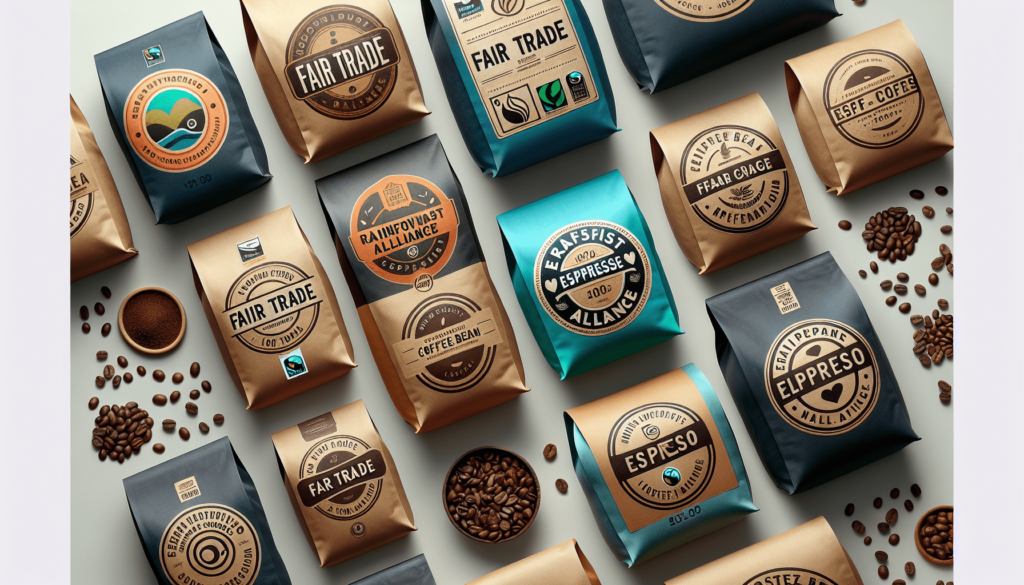Are you a coffee lover who is curious about the different labels and certifications on espresso bean packaging? Look no further! This ultimate guide will provide you with a comprehensive understanding of espresso bean labels and certifications. Whether you’re a seasoned coffee connoisseur or new to the world of espresso, this article is here to help you navigate through the intricate details and make informed choices when it comes to buying the perfect beans for your cup of joe. So let’s embark on a journey to unravel the mysteries behind those labels and certifications, and discover the art of choosing the best espresso beans for your taste buds.
1. Understanding Espresso Bean Labels
1.1 Arabica vs. Robusta
When it comes to espresso beans, the two most common varieties you’ll encounter are Arabica and Robusta. Arabica beans are considered the higher quality option, known for their complex flavors, acidity, and aromatic qualities. They are typically grown at higher altitudes and have a sweeter, more nuanced taste. On the other hand, Robusta beans have a more robust and bitter flavor. They are often used in blends to contribute to a stronger and more intense espresso.
1.2 Single-Origin vs. Blend
Another aspect to consider when choosing espresso beans is whether they are single-origin or a blend. Single-origin beans come from a specific region or farm, allowing you to experience the unique characteristics of that particular area’s coffee. These beans offer a distinct flavor profile and the chance to explore the nuances of different coffee-growing regions. On the other hand, blends combine beans from multiple sources to create a balanced and consistent flavor profile. Blends can be a great choice for those looking for a reliable and well-rounded espresso experience.
1.3 Roast Level
The roast level of espresso beans plays a significant role in determining the overall flavor profile of your coffee. There are four main roast levels: light, medium, dark, and espresso roast. Light roast beans are typically light brown in color and have a milder flavor with higher acidity. Medium roast beans have a slightly darker color and a more balanced flavor, with acidity and sweetness harmoniously blending together. Dark roast beans have a rich and bold flavor with lower acidity and a deep caramelized taste. Espresso roast beans are specifically roasted for use in espresso machines, offering a strong and robust flavor profile.
1.4 Flavor Descriptors
Espresso beans are often accompanied by flavor descriptors that help you understand the taste characteristics of the coffee. These descriptors can range from fruity and floral to nutty and chocolatey. Understanding flavor profiles can guide you in selecting the beans that align with your preferences. For example, if you enjoy bright and fruity flavors, you might look for beans with descriptors like “citrus” or “berry.” On the other hand, if you prefer a more earthy and nutty flavor, descriptors like “cocoa” or “hazelnut” would be more suitable. Exploring different flavor profiles can be an exciting journey for your taste buds.
1.5 Date of Roasting
The date of roasting is an essential factor to consider when purchasing espresso beans. Coffee is at its peak freshness within a few weeks of being roasted, so it’s important to know when the beans were roasted. Fresher beans generally have a more vibrant flavor and aroma compared to beans that have been sitting on the shelf for an extended period. Look for roasting dates on the packaging or ask the retailer about the freshness of the beans. By choosing freshly roasted beans, you can ensure the best possible espresso experience.
2. Decoding Espresso Certifications
2.1 Fair Trade
Fair Trade certification ensures that the beans were produced under fair labor conditions, providing fair wages and promoting sustainable farming practices. When you choose Fair Trade certified espresso beans, you are supporting farmers and communities by promoting ethical and sustainable trade. This certification also guarantees that the beans were cultivated without the use of harmful chemicals, benefiting both the environment and the consumer.
2.2 Organic
Organic certification indicates that the beans were grown without synthetic pesticides or fertilizers. This certification guarantees that the coffee was produced using sustainable farming practices that minimize environmental impact. By choosing organic espresso beans, you can enjoy a cup of coffee that is free from unwanted chemicals and supports the health and well-being of both the farmers and the planet.
2.3 Rainforest Alliance
The Rainforest Alliance certification focuses on promoting environmentally and socially responsible farming practices. It ensures that the coffee beans were grown in a way that protects forests, wildlife habitats, and the livelihoods of local communities. Coffee with this certification indicates that the farming methods used are sustainable and prioritize the well-being of the ecosystem. By purchasing Rainforest Alliance certified espresso beans, you contribute to the preservation of our planet’s valuable resources.
2.4 UTZ Certified
UTZ certification aims to promote sustainable farming practices and improve the lives of farmers. This certification guarantees that the coffee beans are produced in a socially and environmentally responsible manner. UTZ certification covers aspects such as traceability, quality, and farm management practices. By choosing UTZ certified espresso beans, you can have confidence that your coffee was produced with a focus on sustainability and the betterment of communities.

3. Arabica vs. Robusta
3.1 What are Arabica beans?
Arabica beans are widely considered the gold standard in the world of coffee. They are grown at higher altitudes, typically between 2,000 and 6,000 feet, in regions with favorable climates. Arabica beans are known for their delicate and complex flavors, with notes ranging from fruity and floral to caramel and chocolate. They have a higher acidity and a smoother, more nuanced taste compared to their Robusta counterparts.
3.2 What are Robusta beans?
Robusta beans, as the name suggests, are known for their robustness. They are grown at lower altitudes and are more resistant to diseases and pests than Arabica beans. Robusta beans have a stronger and often bitter flavor profile, with earthy and woody notes. They also contain a higher caffeine content compared to Arabica beans, making them a popular choice for those seeking an extra kick of energy.
3.3 Differences in Taste and Aroma
The difference in taste and aroma between Arabica and Robusta beans is quite distinct. Arabica beans offer a more refined and complex flavor, with a pleasant acidity and a wide range of flavor notes. Robusta beans, on the other hand, have a stronger and more bitter taste, with a fuller body. The aroma of Arabica beans tends to be more fragrant and delicate, while Robusta beans have a more robust and earthy aroma. Depending on your preferences, both Arabica and Robusta beans can contribute to a delicious cup of espresso.
4. Single-Origin vs. Blend
4.1 Single-Origin Beans
Single-origin beans come from a specific region or even a single farm, allowing you to experience the unique flavors and characteristics of that particular area. These beans highlight the terroir and farming practices of a specific location, creating distinctive taste profiles. Single-origin beans offer the opportunity to explore the nuances of various coffee-growing regions, such as Ethiopia, Colombia, or Brazil. They provide a more personalized and geographically specific coffee experience.
4.2 Blended Beans
Blended beans combine coffee beans from different regions, creating a harmonious and balanced flavor profile. Roasters carefully craft blends to achieve a consistent taste that appeals to a wide range of palates. Blends often incorporate both Arabica and Robusta beans to create a well-rounded cup of espresso. The art of blending allows roasters to highlight certain flavor characteristics, balance acidity, and enhance body to create a unique and enjoyable espresso experience.
4.3 Pros and Cons
There are pros and cons to both single-origin and blended espresso beans. Single-origin beans offer the chance to explore the unique flavors of different regions, showcasing the distinct terroir and processing methods. They provide a more personalized and adventurous coffee experience. However, flavor profiles can vary significantly between different growing regions, and finding the perfect single-origin bean for your taste preferences may require some experimentation.
Blends, on the other hand, offer a consistent flavor profile that can be enjoyed time and time again. They are carefully crafted to balance acidity, body, and flavor notes, creating a reliable and enjoyable cup of espresso. Blends are a great option for those looking for a well-rounded and consistent coffee experience.
Ultimately, the choice between single-origin and blended espresso beans comes down to personal preference. Whether you enjoy exploring the unique flavors of different regions or prefer a reliable and consistent cup, experimenting with both options can lead to a deeper understanding and appreciation of espresso.

5. Roast Level
5.1 Light Roast
Light roast espresso beans are light brown in color and have a milder flavor profile. They are roasted for a shorter amount of time, allowing the natural flavors of the coffee to shine through. Light roast beans have higher acidity and often exhibit bright and vibrant flavor notes. They are the preferred choice for those who enjoy a more delicate and nuanced espresso experience.
5.2 Medium Roast
Medium roast espresso beans have a slightly darker color and a more balanced flavor profile. The roast time for medium roast beans is longer than for light roast, resulting in a deeper flavor development. Medium roast beans have a medium acidity and offer a pleasant combination of sweetness and complexity. This roast level is favored by those who appreciate a well-rounded cup of espresso with a balance between acidity, body, and flavor.
5.3 Dark Roast
Dark roast espresso beans have a rich and bold flavor profile. They are roasted for a longer period, resulting in a deep caramelization of sugars within the beans. Dark roast beans have a lower acidity compared to lighter roasts and offer a fuller body. They often exhibit smoky and chocolatey flavor notes, producing an intense and robust cup of espresso. Dark roast beans are ideal for those who enjoy a strong and rich espresso with pronounced flavors.
5.4 Espresso Roast
Espresso roast beans are specifically roasted for use in espresso machines, offering a flavor profile optimized for espresso extraction. This roast level is typically on the darker side of the spectrum, providing a more intense and robust flavor. Espresso roast beans are carefully crafted to enhance the body, sweetness, and complexity of the coffee when brewed as espresso. They ensure a concentrated and flavorful shot that is the foundation of various espresso-based drinks, such as lattes and cappuccinos.
6. Flavor Descriptors
6.1 Understanding Flavor Profiles
Flavor profiles are a way to describe the taste characteristics of espresso beans. They provide a common language for coffee enthusiasts to communicate and understand the unique attributes of different coffees. Understanding flavor profiles can help you select beans that align with your taste preferences and allow you to explore a variety of flavor notes.
6.2 Common Espresso Flavor Notes
Espresso beans can exhibit a wide range of flavor notes, creating a diverse and exciting drinking experience. Some common flavor notes you may come across include:
- Fruity: Descriptors like “citrus,” “berry,” or “stone fruit” indicate the presence of fruity flavors in the coffee.
- Floral: Beans with floral flavor notes offer a pleasant aroma reminiscent of flowers, such as jasmine or lavender.
- Nutty: Flavor notes like “hazelnut” or “almond” indicate a characteristic nuttiness in the coffee.
- Chocolatey: Beans with chocolatey flavor notes offer a rich and indulgent taste reminiscent of dark or milk chocolate.
- Caramel: Caramel flavor notes imply a sweet and buttery taste, often with a hint of toffee or molasses.
- Earthy: Beans with earthy flavor notes exhibit a taste profile reminiscent of soil, mushrooms, or woods.
- Spicy: Spicy flavor notes can include descriptors like “cinnamon,” “black pepper,” or “cloves,” adding a warm and aromatic element to the coffee.
These flavor notes are just a starting point, and each person may perceive them differently. Exploring different flavor profiles can help you discover new and exciting combinations that suit your individual taste preferences.
7. Date of Roasting
7.1 Importance of Freshly Roasted Beans
The date of roasting is a crucial factor in ensuring the best possible espresso experience. Coffee beans are at their peak freshness within a few weeks of being roasted. Freshly roasted beans offer vibrant flavors and aromas that can enhance the overall taste of your espresso. As time passes, coffee beans begin to oxidize and lose their desirable characteristics.
7.2 How to Determine the Roasting Date
When purchasing espresso beans, it’s essential to check the roasting date on the packaging. Look for coffee that has been recently roasted, ideally within the past two to four weeks. Some roasters may even provide a specific “roasted on” date on their packaging, allowing you to determine the freshness of the beans accurately. If the roasting date is not readily available, consider reaching out to the retailer or roaster to inquire about the freshness of the beans. By choosing beans that have been recently roasted, you can ensure a more flavorful and enjoyable espresso experience.
8. Fair Trade Certification
8.1 What is Fair Trade Certification?
Fair Trade certification ensures that coffee producers are paid fair wages, work under safe conditions, and receive community development funds. This certification aims to support farmers and promote ethical trading practices. Fair Trade coffee ensures that the farmers receive a fair share of the profits and are protected against exploitation. By choosing Fair Trade certified espresso beans, you can be confident that your coffee is contributing to the well-being of the communities that produce it.
8.2 Benefits of Buying Fair Trade Coffee
Buying Fair Trade coffee has several benefits. Firstly, it supports farmers and promotes sustainable farming practices, ensuring the longevity of coffee-growing communities. Fair Trade certification also guarantees that the coffee was cultivated without the use of harmful chemicals, benefiting both the consumers and the environment. By purchasing Fair Trade certified espresso beans, you are making a positive impact on the lives of coffee producers and the sustainability of the coffee industry as a whole.
9. Organic Certification
9.1 What is Organic Certification?
Organic certification indicates that the coffee beans were grown without the use of synthetic pesticides, herbicides, or fertilizers. Organic coffee is cultivated using sustainable farming practices that prioritize soil health, biodiversity, and long-term sustainability. Organic certification ensures that the coffee is free from unwanted chemicals that can contaminate the environment and potentially impact the health of consumers.
9.2 The Advantages of Organic Espresso Beans
Choosing organic espresso beans offers several advantages. Firstly, you can enjoy a cup of coffee that is free from harmful chemicals, providing a cleaner and more natural beverage. Organic farming practices promote environmental conservation, protecting soil quality, water sources, and wildlife habitats. By supporting organic coffee, you are contributing to the well-being of farmers, ecosystems, and the planet as a whole.
10. Rainforest Alliance and UTZ Certifications
10.1 Understanding Rainforest Alliance
The Rainforest Alliance certification focuses on promoting environmentally and socially responsible farming practices. Coffee beans with the Rainforest Alliance certification indicate that they were grown in a way that protects forests, wildlife habitats, and the livelihoods of local communities. This certification ensures that the coffee is produced using sustainable methods that safeguard the well-being of the ecosystem.
10.2 UTZ Certification and Sustainable Farming
UTZ certification aims to promote sustainable farming practices and improve the lives of farmers. This certification covers aspects such as traceability, quality, and farm management practices. UTZ certified espresso beans guarantee that the coffee was produced in a socially and environmentally responsible manner. By choosing UTZ certified coffee, you can support the ongoing improvement of coffee farming practices and contribute to the well-being of farming communities.
In conclusion, understanding espresso bean labels and certifications can enhance your coffee experience. Consider the differences between Arabica and Robusta beans, the advantages of single-origin or blended beans, and the various roast levels available. Pay attention to flavor descriptors and the date of roasting to ensure the freshest and most flavorful espresso. Additionally, certifications like Fair Trade, Organic, Rainforest Alliance, and UTZ provide insight into the ethical and sustainable practices behind the beans. By exploring and embracing these labels and certifications, you can discover the perfect espresso beans that align with your taste preferences and values.

